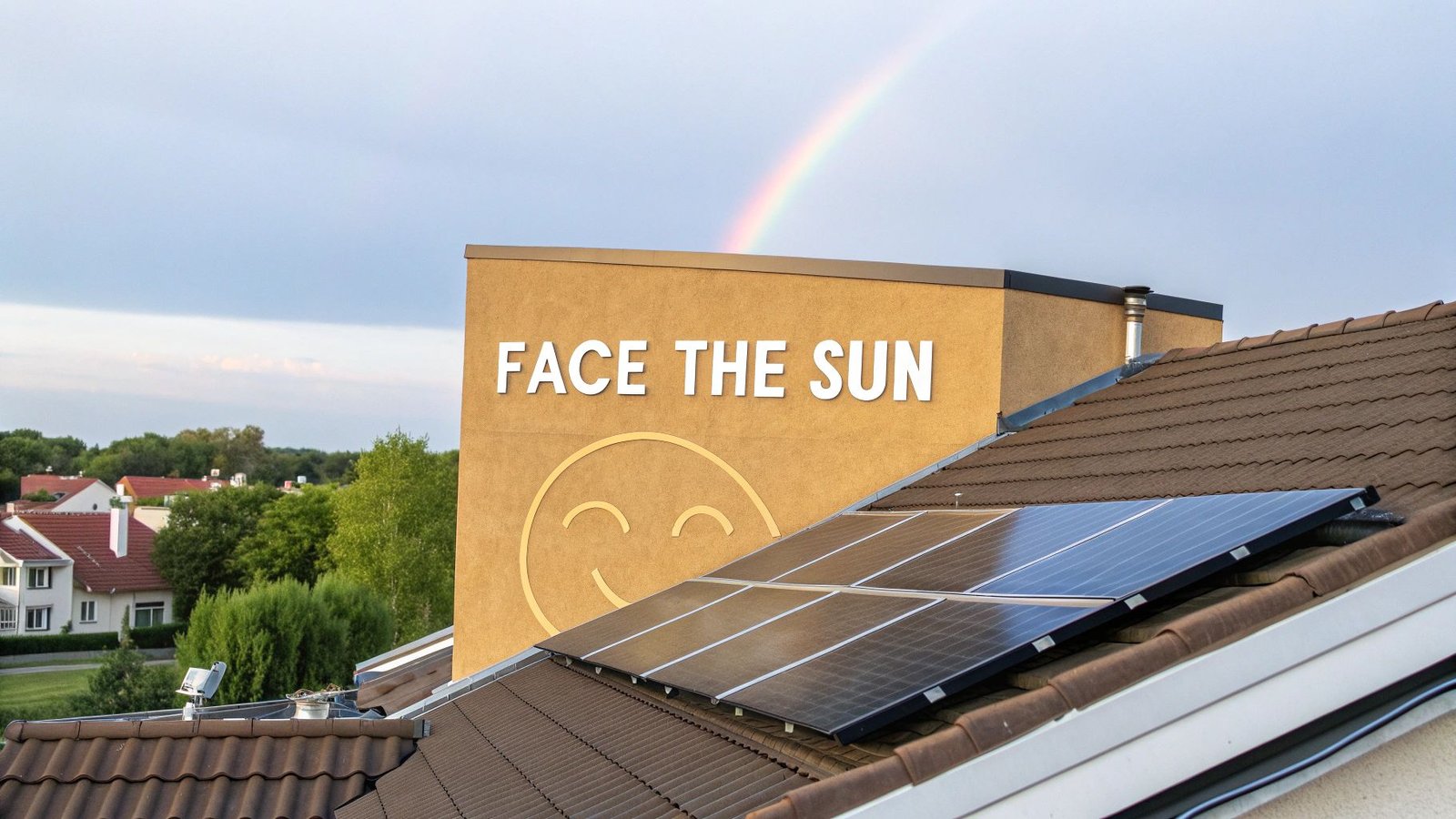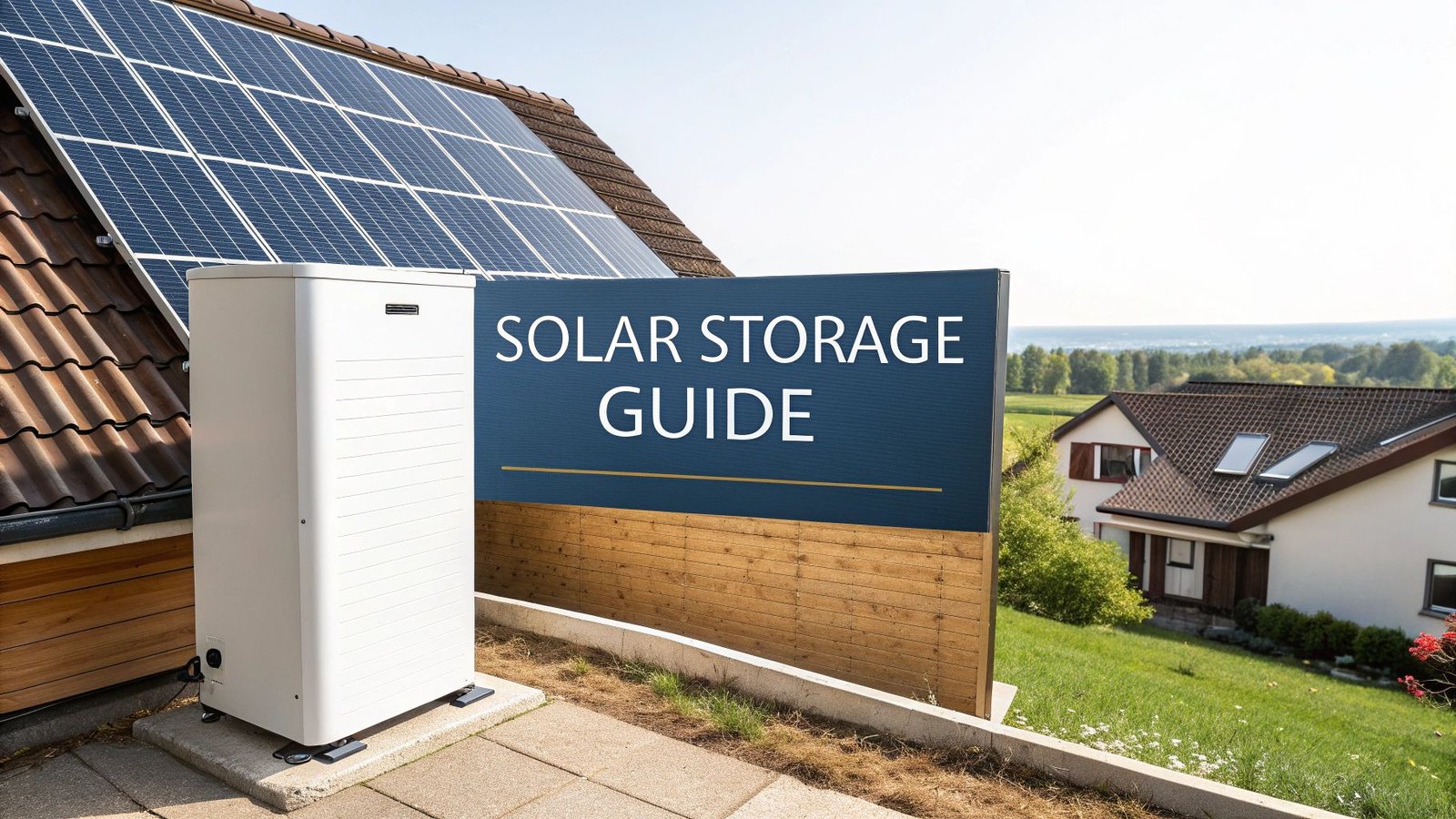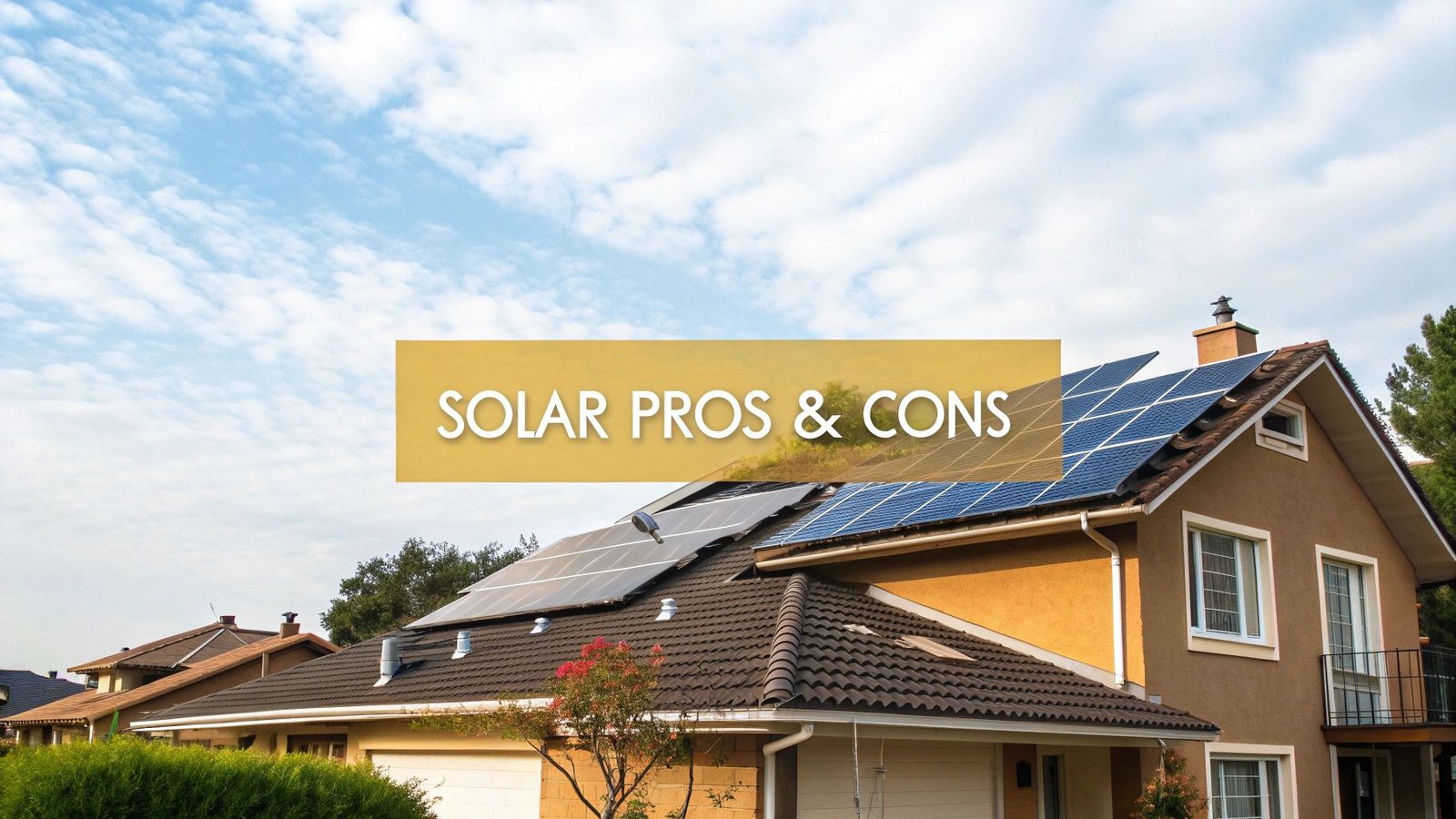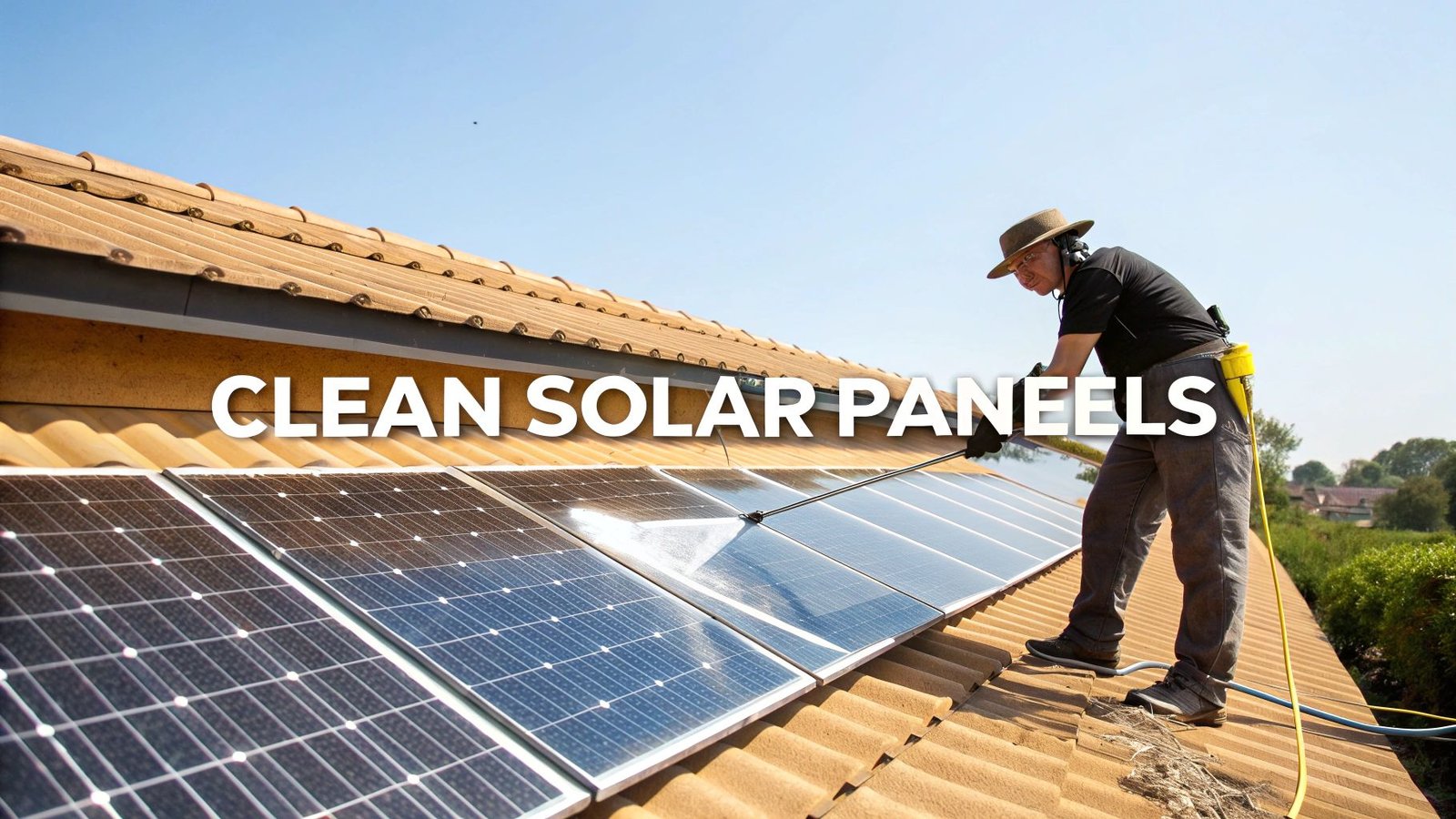If you're wondering which way your solar panels should face, there's a straightforward rule of thumb that makes a huge difference. For anyone in the Northern Hemisphere, the magic direction is verdadero sur. If you live in the Southern Hemisphere, you’ll want them pointing true north.
Getting this one thing right is the cornerstone of a powerful and efficient solar setup. It’s all about maximizing how much sunlight your panels can soak up over the course of a day.
The Best Direction for Your Solar Panels
Think about how a sunflower tracks the sun across the sky—your solar panels need to be positioned to do the same thing, just in a fixed position. By aiming them toward the equator (south for the northern half of the world, north for the southern half), you give them the best possible angle to catch direct sunlight from morning till night.
This simple orientation decision has a massive impact on your system's performance and, ultimately, your return on investment.

When your panels are aligned this way, they sit almost perfectly perpendicular to the sun's path. A panel facing the right direction can capture, on average, about 15-20% more solar energy over a year compared to one that's stuck facing east or west. That’s a significant boost in production.
The optimal direction for solar panels is the single most important factor in maximizing your system's daily energy production and long-term savings.
To simplify this key concept, the table below breaks down the ideal orientation based on where you are in the world. This is the first and most critical step in proper optimización de paneles solares.
Quick Guide to Solar Panel Direction by Hemisphere
This handy table summarizes the core principle for orienting your solar panels for peak performance.
| Hemisphere | Ideal Direction | Reason |
|---|---|---|
| Northern Hemisphere | True South | Faces the sun's consistent path across the southern sky. |
| Southern Hemisphere | True North | Faces the sun's consistent path across the northern sky. |
Remembering this simple rule ensures your solar investment starts off on the right foot, ready to generate as much clean energy as possible.
Why Does Solar Panel Direction Matter So Much?
To really get a feel for why the direction of your solar panels is so important, just think about the sun’s daily trip across the sky. It rises in the east, travels in a huge arc, and sets in the west. Your panels are at their most productive when the sun's rays hit them straight on, at a perfect 90-degree angle.
So, when you aim your panels toward the equator—which means facing south in the Northern Hemisphere—you're basically setting them up to face that arc for as long as possible each day. This isn't just a minor tweak; it's the fundamental secret to getting the most power out of your system.
Catching Every Last Ray of Sun
Think of it like trying to catch a baseball. You wouldn't turn your back to the pitcher, right? You'd face them directly. It’s the same idea with solar panels. South-facing panels are positioned to "catch" the maximum amount of sunlight all day long, which means more electricity for your home and bigger savings on your bills.
This image shows exactly how a south-facing setup works with the sun's path.

As you can see, the panels are perfectly placed to soak up direct sunlight during the most valuable hours, from mid-morning through the late afternoon. This strategic alignment ensures they’re working at peak efficiency right when the sun is at its strongest.
A Quick Note on True South vs. Magnetic South
Here’s a detail that the pros never overlook: the difference between magnetic south (where your compass needle points) and verdadero sur (which is based on the Earth's axis of rotation). For maximum precision, a solar array should always be oriented to verdadero sur.
This ensures the panels are perfectly aligned with the sun's actual path across the sky, not just the planet's wandering magnetic field. It might seem like a small adjustment, but it makes a real, measurable difference in how much energy you generate over the year.
"Getting the orientation right isn't just a best practice—it's the global standard that makes solar power truly effective, no matter where you are in the world."
The results of getting this right speak for themselves on a massive scale. The world's total installed solar capacity has now blown past 2,2 teravatios (TW). It’s no coincidence that countries leading the charge, like Germany and Spain, are sticklers for these orientation rules, which is a big reason they see such high efficiency and fantastic economic returns from their solar investments. You can dig into more on global PV markets and their growth in this report.
Finding the Perfect Tilt Angle for Your Panels
We’ve nailed down the best direction for your solar panels, but that’s only half the story. The other critical piece of the puzzle is the inclinación. Think of it like adjusting a magnifying glass to focus a beam of sunlight—the right angle makes all the difference.
Your panels need to be angled just right to "catch" the maximum amount of sunlight as the sun's position changes throughout the year.
A fantastic rule of thumb, and one we often start with, is to match your panel's tilt angle to your home's latitude. If you live in Denver, Colorado, which sits at a latitude of roughly 40°, tilting your panels at 40 degrees is a great starting point for solid, year-round energy production. It’s a simple, effective baseline.
But if you want to get a little more strategic, you can adjust that tilt to account for the seasons. The sun hangs low in the sky during winter and rides high overhead in the summer. Adjusting for this can squeeze even more power out of your system.

As you can see, a steeper angle is perfect for grabbing that low winter sun, while a shallower angle is better suited for the long, bright days of summer.
Matching Tilt to Your Energy Goals
This is where you can have a really productive conversation with your solar installer. Are you aiming for steady, balanced performance all year, or do you have specific seasonal needs?
For example, if your air conditioning runs non-stop from June to August, you might benefit from a slightly lower tilt angle to maximize your power generation during those peak summer months. Knowing these details is a big part of learning how to size a solar system that truly fits your lifestyle.
Getting the direction and tilt just right can boost your solar panel output by 15-30% compared to a flat or poorly positioned installation. That’s a massive difference.
Studies have shown that dialing in the tilt angle somewhere between 10 to 40 degrees—depending on your specific location—is crucial for hitting peak performance. When both direction and tilt are optimized, you can be sure your solar investment is working as hard as it possibly can for you.
So, what happens if your roof isn't a perfect, south-facing canvas? It's a common worry. Many homeowners think if they don't have that ideal setup, solar is off the table.
Thankfully, that's almost never true. Modern solar systems are surprisingly versatile.
Even if your roof doesn't face due south, your panels can still crank out a ton of power. For instance, panels facing east or west can often generate 80-90% of the energy you'd get from a perfectly south-facing array. It's all about designing a system that works with your roof, not against it.
Solutions for Every Roof
Let's say you have a roof with east and west-facing slopes. A really smart and popular approach here is the "split array." It's exactly what it sounds like: some panels go on the east side to catch that strong morning sun, and the rest go on the west to soak up the afternoon rays.
This setup can be a game-changer for many families. Think about it—your energy production spikes right when you need it most. You get a boost in the morning as everyone's getting ready for work and school, and another surge in the afternoon when you're coming home and firing up the appliances for dinner.
An "imperfect" roof doesn't mean you have to accept mediocre performance. With a little smart design, you can turn a potential challenge into a system that perfectly matches your daily life.
Shade is another big one. What if a neighbor's tree casts a shadow over your roof every afternoon? In the old days, that was a real problem. If one panel in a string got shaded, it would drag down the performance of all the others connected to it.
Today, that problem is basically solved. We now have technologies like microinverters and power optimizers. These brilliant little devices work on a panel-by-panel level. So, if one panel is temporarily in the shade, the rest of your system just keeps chugging along at full power. It’s a simple fix that makes a huge difference in your total energy output.
Solar Panel Orientation Performance Comparison
It’s one thing to talk about it, but seeing the numbers really puts things in perspective. The chart below shows just how much (or how little) of an impact direction has on your annual energy production compared to the "perfect" setup.
graph TD
subgraph Annual Production Efficiency
A[South: 100%]
B[East/West: 80-90%]
C[North: <70%]
end
style A fill:#4CAF50,stroke:#333,stroke-width:2px
style B fill:#FFC107,stroke:#333,stroke-width:2px
style C fill:#F44336,stroke:#333,stroke-width:2px
As you can see, while south is the gold standard for pure annual numbers, an east or west orientation is still incredibly effective—especially when it aligns with your family's daily routine. It's a small trade-off in total production for a big gain in real-world usability.
Advanced Strategies to Maximize Your Solar Output
Once you've figured out the best foundational direction for your panels, you can start looking at ways to squeeze every last watt out of your system. A standard fixed-mount system is great, but a few tweaks and some specialized hardware can really take your energy production to the next level. This is especially important for off-grid homes or anyone with seriously high electricity needs.
A simple but effective strategy is making seasonal tilt adjustments. This just means you manually change the angle of your panels twice a year. You'll want a steeper angle in the winter to catch the low-hanging sun and a shallower one in the summer when the sun is high overhead. It's a small change, but it delivers a noticeable boost.
The Ultimate Solution: Solar Tracking Systems
For those who want to achieve absolute peak performance, solar trackers are the way to go. Instead of staying in one spot, these systems automatically follow the sun's journey across the sky. This ensures your panels are always at the perfect angle to capture the most direct sunlight, all day long. It's a true game-changer for maximizing your output.
There are two main kinds of trackers to consider:
- Seguidores de un eje move with the sun from east to west. Even this simple movement captures a lot more light than a fixed array.
- Dual-axis trackers are the top-tier option. They move east-to-west y north-to-south, adjusting for both the time of day and the changing seasons.
The image below really drives home how orientation, sunlight exposure, and energy output are all tied together.

As you can see, even a small deviation from the ideal angle can cut down on sunlight exposure, which directly impacts how much power you generate. This chart illustrates the potential gains.
gantt
title Solar System Output Comparison
dateFormat X
axisFormat %s%%
section Production Boost Over Fixed South-Facing
Fixed Mount :0, 0
Seasonal Tilt Adjustments :0, 8
Single-Axis Tracker :0, 25
Dual-Axis Tracker :0, 40
While solar trackers do come with a higher upfront cost, they can boost your energy generation by over 25% compared to a fixed system.
That massive increase in production makes them a powerful option, especially when you pair them with the right equipment. You can learn more about cómo elegir paneles solares that work well with these advanced setups. Knowing the right direction is the first step, but a tracking system ensures you never miss a single ray of sun.
Got More Questions About Solar Panel Direction?
It's natural to have a few more questions once you start digging into the details of solar panel orientation. Let's tackle some of the most common ones we hear from homeowners.
So, Do My Panels Have to Face South?
Not at all. While a perfect southern orientation is the textbook ideal in the Northern Hemisphere, it's definitely not a deal-breaker. Panels facing east or west can still produce about 80-90% of the power you'd get from a south-facing array.
In fact, an east-west setup can be a smart move. It often aligns better with when your family actually uses the most electricity—giving you a nice power boost during the morning and afternoon rush hours.
How Much Power Am I Really Losing with a "Wrong" Angle?
You'd be surprised how forgiving modern panels are. A slight deviation from that perfect tilt or direction usually results in a very small drop in energy production.
If your panels are off by about 15 grados, you might only see your annual output dip by a few percentage points. A professional installer uses specialized software to model these effects precisely for your specific roof, so you know exactly what to expect.
Don't let a less-than-perfect roof hold you back. Today's solar technology is so efficient that you can still see incredible energy production and major savings on your utility bills.
Is It Worth Looking into a Ground-Mounted System?
A ground-mounted system can be a fantastic solution if your roof just isn't cutting it. It's the go-to alternative when a roof has:
- A tricky orientation
- Too much shade from trees or other buildings
- Structural issues
The biggest benefit? You're not limited by your roof's existing structure. A ground mount lets you position the panels for the absolute best direction and tilt, which can often lead to even higher energy production than you'd get from a compromised rooftop installation.
Ready to see how the right solar panel orientation can slash your energy bills? The experts at Energía radiante design custom solar solutions to maximize your home's unique potential. Get your free solar assessment today!




